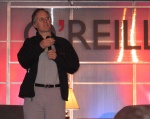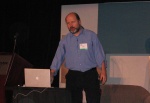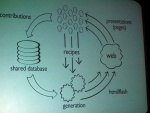Bear Flag Republic Radio WeblogLiving out on the left coast |
| Last modified: |
|
4/1/05; 10:07:50 AM |
| Feeds: |
|
LIVE webcam Cumbres & Toltec rail yard in Chama, New Mexico.
Current BlogRoll. |
|
Tuesday, March 15, 2005
Fedora Core 4 Test 1 released. Fedora Core 4 Test 1 has been released. This release comes with prereleases of GNOME 2.10, KDE 3.4, ... [Tom's Hardware Guide: Hard News]
comments < 8:16:50 PM PHP 5 Power Programming [Slashdot:] comments < 7:38:16 PM How Things Start to Go Mainstream. RSS: Yahoo! Toolbar (IE) Adds Auto-Detect of RSS Feeds Podcasting: Podcasting the Cubs Cell Phone Jukebox: The M4300, LG’s Musicphone [The Shifted Librarian] comments < 7:21:35 PM Web Services Mashup. There were several good tutorials yesterday and unfortunately, I couldn't attend them all, but I did run across this great list of Web services APIs from the Web Services Mashup tutorial. I'm listening to Rael's opening keynote on the conference theme, Remix, right now and this list goes along beautifully with that theme. After all, these APIs are about remixing data and services. [Phil Windley's Technometria]comments < 7:20:23 PM O'Reilly's Radar: Remix Patterns.
Tim's keynote was on patterns for remixing. Patterns consist of three parts: an issue, a prescription, and examples. Here are some of Tim's patterns (I missed much of it): Issue: A successful open source project consists of "small pieces, loosely joined." Therefore: Architect your software or service so as to be used easily as a component of a larger system: keep it modular, document your interfaces and use a license that doesn't hinder the recombinations. Example: missed it Issue: There is great benefit to sharing your development efforts with users Therefore: release early and often. Set up mechanisms for user feedback, bug reports and so on. Issue: On today's web you no longer need to build or own all the components of your application. Example: isbn.nu Therefore: don't lock away the interfaces to your ecommerce application. Issue: When devices and program are connected to the Internet, applications are no longer software artifacts, they're on-going services. Therefore: don't package up new features into monolithic releases, rather, fold them in on a regular basis. Let your users into the process. Engage your users as real-time testers and instrument such that you know how new features are faring. Operate as if you're in perpetual beta. Examples: Google, Flickr, del.icio.us, Safari U. Issue: The key to competitive advantage in networked applications is the extent to which users augment your data with their own. Therefore: Architect for participation beyond design and development. Example: Amazon using its user's intelligence to create new value. Adding user data to their own. Issue: Only a small percentage of user will go to the trouble of explicitly adding value. Therefore: make participation the default, aggregating user data as a side-effect of their using your application. Example: Flickr's defaults for sharing is for "everyone." The default for annotation is "open." Issue: Many of the limiting factors from the physical world are absent on the Internet. Therefore: Use the power of the computer to monetize niches formerly too small to be commercial. Example: Google Ad Sense. Issue: The PC is no longer the only access point for networked applications. Therefore: Design your application from the get-go to integrate services and share data on multiple devices. Example: iSync. Issue: Social networking are a by-product of social application like email, instant messaging, photo sharing, and book buying. Therefore: Architect your application to capture and share the social fabric underlying you application (rather than artificially constructing another. Example: The ETech Attention Stream (which is displayed on a flat panel in the lobby). Issue: As demonstrated by container shipping, IP packages, and HTML pages, a standard content-agnostic packet is the most effective way to ship for good and data. Therefore: Understand the optimum "packet size" for your application domain and devise products that fit it. Example: Books don't fit on a Web page. O'Reilly Make and the new Cookbook series are examples of repackaging content in an effort to more closely match the right "packet size." Issue: When content is digital, it lends itself to being broken down and remixed. Therefore: Create your business model so that it make money from the atomic units of your products. Example: Safari U. Although they're not patterns, Tim also mentions AJAX and Ruby on Rails. [Phil Windley's Technometria]comments < 7:19:50 PM Danny Hillis on Applied Minds.
Danny Hillis (who founded Thing Machines, the Long Now, and lots of other cool stuff) is speaking about his current business: Applied Minds, which he calls a "maketank" as opposed to a thinktank. I like that term. That's a good description of what Computer Science labs ought to be like. He's showing videos of robots "not because that's a big part of what we do, but because it makes for a good show" that are really cool. He's showing a picture of an ultimate vehicle hack. He says they do things like that as bait to get companies to come talk to them. What's your bait? He's showing a map table that gives the feel of a paper map, but with all the properties of a large paper map (except that its infinite). He also has a table that physically deforms to show the contours of maps that are displayed on it.
If you look at how a blog or wiki work, the model is that contributers put things in a database and the publisher has a recipe for how to show the data. The problem with this model is that all the databases are islands--not shared. He proposes a new twist with a shared database and recipes. This is, in a way, the idea behind data in XML on the Web. He's calling this sharing and rendering of public databases as the "metaweb." [Phil Windley's Technometria]comments < 7:18:30 PM Nelson Minar at the Google AdWords API. AdWords is the little ads on the side of Google's page and the also show up on third party sites. The traditional way to do campaign management is done by Web application. But, when an advertiser has 1000's of keywords, its hard to manage them through a Web application. There's a hierarchical data model: campaigns contain adwords which contain keywords. The goal of the API is to allow developers to integrate with the AdWords platform. There are a number of applications: typical bid management, ROI optimization, keyword optimization, integrating advertising with backend systems, and new UI ideas. Nelson wants to create a third party developer community who can add value on top of the platform. Primary features:
The core technologies are:
There are retailers using the API to manage seasonal CPCs, third party developers making tools, and small users changing their spend and increasing their click-thrus. Nelson's goal was to make simple function calls work so that API doesn't require developers to know XML. Their experience was that interoperability is still hard. WSDL support varies by toolkit. SOAP document/literal support also varies by toolkit. Here's his breakdown:
Here's a real world example of interop problems: Sending nothing is hard. You could send: <foo xsi:nil="true"/> <foo/> nothing <foo>-1</foo> Axis likes the first, but .NET fials, the second is not valid. The third is OK, the last =may be the easiest. Here are some hazards:
He characterizes REST as "low REST" and "high REST." Low REST is GETS everyewhere. High REST uses HTTP semantics to build APIs. In High REST:
He notes some limitations:
What went right:
Things that went wrong:
WS-Security might be the answer, but can we rely on it? Some more:
To create a program for user:
comments < 7:17:15 PM |
| Archive: | ||||||||||||||||||||||||||||||||||||||||||||||||||||||||
|
||||||||||||||||||||||||||||||||||||||||||||||||||||||||
|



